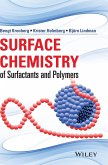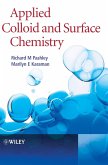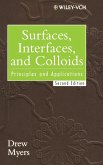Colloid Science
Herausgegeben von Cosgrove, Terence
Colloid Science
Herausgegeben von Cosgrove, Terence
- Gebundenes Buch
- Merkliste
- Auf die Merkliste
- Bewerten Bewerten
- Teilen
- Produkt teilen
- Produkterinnerung
- Produkterinnerung
Colloidal systems are important across a range of industries, such as the food, pharmaceutical, agrochemical, cosmetics, polymer, paint and oil industries, and form the basis of a wide range of products (eg cosmetics & toiletries, processed foodstuffs and photographic film). A detailed understanding of their formation, control and application is required in those industries, yet many new graduate or postgraduate chemists or chemical engineers have little or no direct experience of colloids.
Based on lectures given at the highly successful Bristol Colloid Centre Spring School, Colloid…mehr
Andere Kunden interessierten sich auch für
![Colloid Science Colloid Science]() Colloid Science69,99 €
Colloid Science69,99 €![Surface Chemistry of Surfactants and Polymers Surface Chemistry of Surfactants and Polymers]() Bengt KronbergSurface Chemistry of Surfactants and Polymers111,99 €
Bengt KronbergSurface Chemistry of Surfactants and Polymers111,99 €![Applied Colloid and Surface Chemistry Applied Colloid and Surface Chemistry]() Richard M. PashleyApplied Colloid and Surface Chemistry227,99 €
Richard M. PashleyApplied Colloid and Surface Chemistry227,99 €![Colloids and Interfaces with Surfactants and Polymers Colloids and Interfaces with Surfactants and Polymers]() James GoodwinColloids and Interfaces with Surfactants and Polymers74,99 €
James GoodwinColloids and Interfaces with Surfactants and Polymers74,99 €![Colloids and Interfaces with Surfactants and Polymers Colloids and Interfaces with Surfactants and Polymers]() James GoodwinColloids and Interfaces with Surfactants and Polymers176,99 €
James GoodwinColloids and Interfaces with Surfactants and Polymers176,99 €![Surfaces, Interfaces, and Colloids Surfaces, Interfaces, and Colloids]() Drew MyersSurfaces, Interfaces, and Colloids251,99 €
Drew MyersSurfaces, Interfaces, and Colloids251,99 €![Name Reactions for Homologation, 2 Part Set Name Reactions for Homologation, 2 Part Set]() Name Reactions for Homologation, 2 Part Set317,99 €
Name Reactions for Homologation, 2 Part Set317,99 €-
-
-
Colloidal systems are important across a range of industries, such as the food, pharmaceutical, agrochemical, cosmetics, polymer, paint and oil industries, and form the basis of a wide range of products (eg cosmetics & toiletries, processed foodstuffs and photographic film). A detailed understanding of their formation, control and application is required in those industries, yet many new graduate or postgraduate chemists or chemical engineers have little or no direct experience of colloids.
Based on lectures given at the highly successful Bristol Colloid Centre Spring School, Colloid Science: Principles, Methods and Applications provides a thorough introduction to colloid science for industrial chemists, technologists and engineers. Lectures are collated and presented in a coherent and logical text on practical colloid science.
Hinweis: Dieser Artikel kann nur an eine deutsche Lieferadresse ausgeliefert werden.
Based on lectures given at the highly successful Bristol Colloid Centre Spring School, Colloid Science: Principles, Methods and Applications provides a thorough introduction to colloid science for industrial chemists, technologists and engineers. Lectures are collated and presented in a coherent and logical text on practical colloid science.
Hinweis: Dieser Artikel kann nur an eine deutsche Lieferadresse ausgeliefert werden.
Produktdetails
- Produktdetails
- Verlag: Wiley & Sons
- 2. Aufl.
- Seitenzahl: 398
- Erscheinungstermin: 26. April 2010
- Englisch
- Abmessung: 250mm x 175mm x 26mm
- Gewicht: 804g
- ISBN-13: 9781444320190
- ISBN-10: 144432019X
- Artikelnr.: 30602445
- Herstellerkennzeichnung
- Libri GmbH
- Europaallee 1
- 36244 Bad Hersfeld
- gpsr@libri.de
- Verlag: Wiley & Sons
- 2. Aufl.
- Seitenzahl: 398
- Erscheinungstermin: 26. April 2010
- Englisch
- Abmessung: 250mm x 175mm x 26mm
- Gewicht: 804g
- ISBN-13: 9781444320190
- ISBN-10: 144432019X
- Artikelnr.: 30602445
- Herstellerkennzeichnung
- Libri GmbH
- Europaallee 1
- 36244 Bad Hersfeld
- gpsr@libri.de
Terence Cosgrove is Professor of Physical Chemistry at the University of Bristol. Terence is a world expert in polymer chemistry and is fascinated by how polymers stick to surfaces. He is Director and Chief Scientific Officer of the Bristol University spin-out company, Revolymer. This is a polymer technology company which has patented a low adhesion chewing gum which can be removed easily from the streets. Terence developed the science behind removable chewing gum and the principle behind the technology can also be applied to many other markets and products. He is the author of over 150 papers and patents.
Preface.
Introduction.
Acknowledgements.
List of Contributors.
1 An Introduction to Colloids (Roy Hughes).
1.1 Introduction.
1.2 Basic Definitions.
1.3 Stability.
1.4 Colloid Frontiers.
2 Charge in Colloidal Systems (David Fermin and Jason Riley).
2.1 Introduction.
2.2 The Origin of Surface Charge.
2.3 The Electrochemical Double Layer.
2.4 Electrokinetic Properties.
3 Stability of Charge-stabilised Colloids (John Eastman).
3.1 Introduction.
3.2 The Colloidal Pair Potential.
3.3 Criteria for Stability.
3.4 Kinetics of Coagulation.
3.5 Conclusions.
4 Surfactant Aggregation and Adsorption at Interfaces (Julian Eastoe).
4.1 Introduction.
4.2 Characteristic Features of Surfactants.
4.3 Classification and Applications of Surfactants.
4.4 Adsorption of Surfactants at Interfaces.
4.5 Surfactant Solubility.
4.6 Micellisation.
4.7 Liquid Crystalline Mesophases.
4.8 Advanced Surfactants.
5 Microemulsions (Julian Eastoe).
5.1 Introduction.
5.2 Microemulsions: Definition and History.
5.3 Theory of Formation and Stability.
5.4 Physicochemical Properties.
5.5 Developments and Applications.
6 Emulsions (Brian Vincent).
6.1 Introduction.
6.2 Preparation.
6.3 Stability.
7 Polymers and Polymer Solutions (Terence Cosgrove).
7.1 Introduction.
7.2 Polymerisation.
7.3 Copolymers.
7.4 Polymer Physical Properties.
7.5 Polymer Uses.
7.6 Theoretical Models of Polymer Structure.
7.7 Measuring Polymer Molecular Weight.
7.8 Flory-Huggins Theory.
8 Polymers at Interfaces (Terence Cosgrove).
8.1 Introduction.
8.2 Adsorption of Polymers.
8.3 Models and Simulations for Terminally Attached Chains.
8.4 Experimental Aspects.
8.5 Copolymers.
8.6 Polymer Brushes.
8.7 Conclusions.
9 Effect of Polymers on Colloid Stability (Jeroen van Duijneveldt).
9.1 Introduction.
9.2 Particle Interaction Potential.
9.3 Steric Stabilisation.
9.4 Depletion Interactions.
9.5 Bridging Interactions.
9.6 Conclusion.
10 Wetting of Surfaces (Paul Reynolds).
10.1 Introduction.
10.2 Surfaces and Definitions.
10.3 Surface Tension.
10.4 Surface Energy.
10.5 Contact Angles.
10.6 Wetting.
10.7 Liquid Spreading and Spreading Coefficients.
10.8 Cohesion and Adhesion.
10.9 Two Liquids on a Surface.
10.10 Detergency.
10.11 Spreading of a Liquid on a Liquid.
10.12 Characterisation of a Solid Surface.
10.13 Polar and Dispersive Components.
10.14 Polar Materials.
10.15 Wettability Envelopes.
10.16 Measurement Methods.
10.17 Conclusions.
11 Aerosols (Nana-Owusua A. Kwamena and Jonathan P. Reid).
11.1 Introduction.
11.2 Generating and Sampling Aerosols.
11.3 Determining the Particle Concentration and Size.
11.4 Determining Particle Composition.
11.5 The Equilibrium State of Aerosols.
11.6 The Kinetics of Aerosol Transformation.
11.7 Concluding Remarks.
12 Practical Rheology (Roy Hughes).
12.1 Introduction.
12.2 Making Measurements.
12.3 Rheometry and Viscoelasticity.
12.4 Examples of Soft Materials.
12.5 Summary.
13 Scattering and Reflection Techniques (Robert Richardson).
13.1 Introduction.
13.2 The Principle of a Scattering Experiment.
13.3 Radiation for Scattering Experiments.
13.4 Light Scattering.
13.5 Dynamic Light Scattering.
13.6 Small Angle Scattering.
13.7 Sources of Radiation.
13.8 Small Angle Scattering Apparatus.
13.9 Scattering and Absorption by Atoms.
13.10 Scattering Length Density.
13.11 Small Angle Scattering from a Dispersion.
13.12 Form Factor for Spherical Particles.
13.13 Determining Particle Size from SANS and SAXS.
13.14 Guinier Plots to Determine Radius of Gyration.
13.15 Determination of Particle Shape.
13.16 Polydispersity.
13.17 Determination of Particle Size Distribution.
13.18 Alignment of Anisotropic Particles.
13.19 Concentrated Dispersions.
13.20 Contrast Variation Using SANS.
13.21 High Q Limit: Porod Law.
13.22 Introduction to X-Ray and Neutron Reflection.
13.23 Reflection Experiment.
13.24 A Simple Example of a Reflection Measurement.
13.25 Conclusion.
14 Optical Manipulation (Paul Bartlett).
14.1 Introduction.
14.2 Manipulating Matter with Light.
14.3 Force Generation in Optical Tweezers.
14.4 Nanofabrication.
14.5 Single Particle Dynamics.
14.6 Conclusions.
15 Electron Microscopy (Sean Davis).
15.1 General Features of (Electron) Optical Imaging Systems.
15.2 Conventional TEM.
15.3 Conventional SEM.
15.4 Summary.
16 Surface Forces (Wuge Briscoe).
16.1 Introduction.
16.2 Forces and Energy; Size and Shape.
16.3 Surface Force Measurement Techniques.
16.4 Different Types of Surface Forces.
16.5 Recent Examples of Surface Force Measurement.
16.6 Future Challenges.
References.
Index.
Introduction.
Acknowledgements.
List of Contributors.
1 An Introduction to Colloids (Roy Hughes).
1.1 Introduction.
1.2 Basic Definitions.
1.3 Stability.
1.4 Colloid Frontiers.
2 Charge in Colloidal Systems (David Fermin and Jason Riley).
2.1 Introduction.
2.2 The Origin of Surface Charge.
2.3 The Electrochemical Double Layer.
2.4 Electrokinetic Properties.
3 Stability of Charge-stabilised Colloids (John Eastman).
3.1 Introduction.
3.2 The Colloidal Pair Potential.
3.3 Criteria for Stability.
3.4 Kinetics of Coagulation.
3.5 Conclusions.
4 Surfactant Aggregation and Adsorption at Interfaces (Julian Eastoe).
4.1 Introduction.
4.2 Characteristic Features of Surfactants.
4.3 Classification and Applications of Surfactants.
4.4 Adsorption of Surfactants at Interfaces.
4.5 Surfactant Solubility.
4.6 Micellisation.
4.7 Liquid Crystalline Mesophases.
4.8 Advanced Surfactants.
5 Microemulsions (Julian Eastoe).
5.1 Introduction.
5.2 Microemulsions: Definition and History.
5.3 Theory of Formation and Stability.
5.4 Physicochemical Properties.
5.5 Developments and Applications.
6 Emulsions (Brian Vincent).
6.1 Introduction.
6.2 Preparation.
6.3 Stability.
7 Polymers and Polymer Solutions (Terence Cosgrove).
7.1 Introduction.
7.2 Polymerisation.
7.3 Copolymers.
7.4 Polymer Physical Properties.
7.5 Polymer Uses.
7.6 Theoretical Models of Polymer Structure.
7.7 Measuring Polymer Molecular Weight.
7.8 Flory-Huggins Theory.
8 Polymers at Interfaces (Terence Cosgrove).
8.1 Introduction.
8.2 Adsorption of Polymers.
8.3 Models and Simulations for Terminally Attached Chains.
8.4 Experimental Aspects.
8.5 Copolymers.
8.6 Polymer Brushes.
8.7 Conclusions.
9 Effect of Polymers on Colloid Stability (Jeroen van Duijneveldt).
9.1 Introduction.
9.2 Particle Interaction Potential.
9.3 Steric Stabilisation.
9.4 Depletion Interactions.
9.5 Bridging Interactions.
9.6 Conclusion.
10 Wetting of Surfaces (Paul Reynolds).
10.1 Introduction.
10.2 Surfaces and Definitions.
10.3 Surface Tension.
10.4 Surface Energy.
10.5 Contact Angles.
10.6 Wetting.
10.7 Liquid Spreading and Spreading Coefficients.
10.8 Cohesion and Adhesion.
10.9 Two Liquids on a Surface.
10.10 Detergency.
10.11 Spreading of a Liquid on a Liquid.
10.12 Characterisation of a Solid Surface.
10.13 Polar and Dispersive Components.
10.14 Polar Materials.
10.15 Wettability Envelopes.
10.16 Measurement Methods.
10.17 Conclusions.
11 Aerosols (Nana-Owusua A. Kwamena and Jonathan P. Reid).
11.1 Introduction.
11.2 Generating and Sampling Aerosols.
11.3 Determining the Particle Concentration and Size.
11.4 Determining Particle Composition.
11.5 The Equilibrium State of Aerosols.
11.6 The Kinetics of Aerosol Transformation.
11.7 Concluding Remarks.
12 Practical Rheology (Roy Hughes).
12.1 Introduction.
12.2 Making Measurements.
12.3 Rheometry and Viscoelasticity.
12.4 Examples of Soft Materials.
12.5 Summary.
13 Scattering and Reflection Techniques (Robert Richardson).
13.1 Introduction.
13.2 The Principle of a Scattering Experiment.
13.3 Radiation for Scattering Experiments.
13.4 Light Scattering.
13.5 Dynamic Light Scattering.
13.6 Small Angle Scattering.
13.7 Sources of Radiation.
13.8 Small Angle Scattering Apparatus.
13.9 Scattering and Absorption by Atoms.
13.10 Scattering Length Density.
13.11 Small Angle Scattering from a Dispersion.
13.12 Form Factor for Spherical Particles.
13.13 Determining Particle Size from SANS and SAXS.
13.14 Guinier Plots to Determine Radius of Gyration.
13.15 Determination of Particle Shape.
13.16 Polydispersity.
13.17 Determination of Particle Size Distribution.
13.18 Alignment of Anisotropic Particles.
13.19 Concentrated Dispersions.
13.20 Contrast Variation Using SANS.
13.21 High Q Limit: Porod Law.
13.22 Introduction to X-Ray and Neutron Reflection.
13.23 Reflection Experiment.
13.24 A Simple Example of a Reflection Measurement.
13.25 Conclusion.
14 Optical Manipulation (Paul Bartlett).
14.1 Introduction.
14.2 Manipulating Matter with Light.
14.3 Force Generation in Optical Tweezers.
14.4 Nanofabrication.
14.5 Single Particle Dynamics.
14.6 Conclusions.
15 Electron Microscopy (Sean Davis).
15.1 General Features of (Electron) Optical Imaging Systems.
15.2 Conventional TEM.
15.3 Conventional SEM.
15.4 Summary.
16 Surface Forces (Wuge Briscoe).
16.1 Introduction.
16.2 Forces and Energy; Size and Shape.
16.3 Surface Force Measurement Techniques.
16.4 Different Types of Surface Forces.
16.5 Recent Examples of Surface Force Measurement.
16.6 Future Challenges.
References.
Index.
Preface.
Introduction.
Acknowledgements.
List of Contributors.
1 An Introduction to Colloids (Roy Hughes).
1.1 Introduction.
1.2 Basic Definitions.
1.3 Stability.
1.4 Colloid Frontiers.
2 Charge in Colloidal Systems (David Fermin and Jason Riley).
2.1 Introduction.
2.2 The Origin of Surface Charge.
2.3 The Electrochemical Double Layer.
2.4 Electrokinetic Properties.
3 Stability of Charge-stabilised Colloids (John Eastman).
3.1 Introduction.
3.2 The Colloidal Pair Potential.
3.3 Criteria for Stability.
3.4 Kinetics of Coagulation.
3.5 Conclusions.
4 Surfactant Aggregation and Adsorption at Interfaces (Julian Eastoe).
4.1 Introduction.
4.2 Characteristic Features of Surfactants.
4.3 Classification and Applications of Surfactants.
4.4 Adsorption of Surfactants at Interfaces.
4.5 Surfactant Solubility.
4.6 Micellisation.
4.7 Liquid Crystalline Mesophases.
4.8 Advanced Surfactants.
5 Microemulsions (Julian Eastoe).
5.1 Introduction.
5.2 Microemulsions: Definition and History.
5.3 Theory of Formation and Stability.
5.4 Physicochemical Properties.
5.5 Developments and Applications.
6 Emulsions (Brian Vincent).
6.1 Introduction.
6.2 Preparation.
6.3 Stability.
7 Polymers and Polymer Solutions (Terence Cosgrove).
7.1 Introduction.
7.2 Polymerisation.
7.3 Copolymers.
7.4 Polymer Physical Properties.
7.5 Polymer Uses.
7.6 Theoretical Models of Polymer Structure.
7.7 Measuring Polymer Molecular Weight.
7.8 Flory-Huggins Theory.
8 Polymers at Interfaces (Terence Cosgrove).
8.1 Introduction.
8.2 Adsorption of Polymers.
8.3 Models and Simulations for Terminally Attached Chains.
8.4 Experimental Aspects.
8.5 Copolymers.
8.6 Polymer Brushes.
8.7 Conclusions.
9 Effect of Polymers on Colloid Stability (Jeroen van Duijneveldt).
9.1 Introduction.
9.2 Particle Interaction Potential.
9.3 Steric Stabilisation.
9.4 Depletion Interactions.
9.5 Bridging Interactions.
9.6 Conclusion.
10 Wetting of Surfaces (Paul Reynolds).
10.1 Introduction.
10.2 Surfaces and Definitions.
10.3 Surface Tension.
10.4 Surface Energy.
10.5 Contact Angles.
10.6 Wetting.
10.7 Liquid Spreading and Spreading Coefficients.
10.8 Cohesion and Adhesion.
10.9 Two Liquids on a Surface.
10.10 Detergency.
10.11 Spreading of a Liquid on a Liquid.
10.12 Characterisation of a Solid Surface.
10.13 Polar and Dispersive Components.
10.14 Polar Materials.
10.15 Wettability Envelopes.
10.16 Measurement Methods.
10.17 Conclusions.
11 Aerosols (Nana-Owusua A. Kwamena and Jonathan P. Reid).
11.1 Introduction.
11.2 Generating and Sampling Aerosols.
11.3 Determining the Particle Concentration and Size.
11.4 Determining Particle Composition.
11.5 The Equilibrium State of Aerosols.
11.6 The Kinetics of Aerosol Transformation.
11.7 Concluding Remarks.
12 Practical Rheology (Roy Hughes).
12.1 Introduction.
12.2 Making Measurements.
12.3 Rheometry and Viscoelasticity.
12.4 Examples of Soft Materials.
12.5 Summary.
13 Scattering and Reflection Techniques (Robert Richardson).
13.1 Introduction.
13.2 The Principle of a Scattering Experiment.
13.3 Radiation for Scattering Experiments.
13.4 Light Scattering.
13.5 Dynamic Light Scattering.
13.6 Small Angle Scattering.
13.7 Sources of Radiation.
13.8 Small Angle Scattering Apparatus.
13.9 Scattering and Absorption by Atoms.
13.10 Scattering Length Density.
13.11 Small Angle Scattering from a Dispersion.
13.12 Form Factor for Spherical Particles.
13.13 Determining Particle Size from SANS and SAXS.
13.14 Guinier Plots to Determine Radius of Gyration.
13.15 Determination of Particle Shape.
13.16 Polydispersity.
13.17 Determination of Particle Size Distribution.
13.18 Alignment of Anisotropic Particles.
13.19 Concentrated Dispersions.
13.20 Contrast Variation Using SANS.
13.21 High Q Limit: Porod Law.
13.22 Introduction to X-Ray and Neutron Reflection.
13.23 Reflection Experiment.
13.24 A Simple Example of a Reflection Measurement.
13.25 Conclusion.
14 Optical Manipulation (Paul Bartlett).
14.1 Introduction.
14.2 Manipulating Matter with Light.
14.3 Force Generation in Optical Tweezers.
14.4 Nanofabrication.
14.5 Single Particle Dynamics.
14.6 Conclusions.
15 Electron Microscopy (Sean Davis).
15.1 General Features of (Electron) Optical Imaging Systems.
15.2 Conventional TEM.
15.3 Conventional SEM.
15.4 Summary.
16 Surface Forces (Wuge Briscoe).
16.1 Introduction.
16.2 Forces and Energy; Size and Shape.
16.3 Surface Force Measurement Techniques.
16.4 Different Types of Surface Forces.
16.5 Recent Examples of Surface Force Measurement.
16.6 Future Challenges.
References.
Index.
Introduction.
Acknowledgements.
List of Contributors.
1 An Introduction to Colloids (Roy Hughes).
1.1 Introduction.
1.2 Basic Definitions.
1.3 Stability.
1.4 Colloid Frontiers.
2 Charge in Colloidal Systems (David Fermin and Jason Riley).
2.1 Introduction.
2.2 The Origin of Surface Charge.
2.3 The Electrochemical Double Layer.
2.4 Electrokinetic Properties.
3 Stability of Charge-stabilised Colloids (John Eastman).
3.1 Introduction.
3.2 The Colloidal Pair Potential.
3.3 Criteria for Stability.
3.4 Kinetics of Coagulation.
3.5 Conclusions.
4 Surfactant Aggregation and Adsorption at Interfaces (Julian Eastoe).
4.1 Introduction.
4.2 Characteristic Features of Surfactants.
4.3 Classification and Applications of Surfactants.
4.4 Adsorption of Surfactants at Interfaces.
4.5 Surfactant Solubility.
4.6 Micellisation.
4.7 Liquid Crystalline Mesophases.
4.8 Advanced Surfactants.
5 Microemulsions (Julian Eastoe).
5.1 Introduction.
5.2 Microemulsions: Definition and History.
5.3 Theory of Formation and Stability.
5.4 Physicochemical Properties.
5.5 Developments and Applications.
6 Emulsions (Brian Vincent).
6.1 Introduction.
6.2 Preparation.
6.3 Stability.
7 Polymers and Polymer Solutions (Terence Cosgrove).
7.1 Introduction.
7.2 Polymerisation.
7.3 Copolymers.
7.4 Polymer Physical Properties.
7.5 Polymer Uses.
7.6 Theoretical Models of Polymer Structure.
7.7 Measuring Polymer Molecular Weight.
7.8 Flory-Huggins Theory.
8 Polymers at Interfaces (Terence Cosgrove).
8.1 Introduction.
8.2 Adsorption of Polymers.
8.3 Models and Simulations for Terminally Attached Chains.
8.4 Experimental Aspects.
8.5 Copolymers.
8.6 Polymer Brushes.
8.7 Conclusions.
9 Effect of Polymers on Colloid Stability (Jeroen van Duijneveldt).
9.1 Introduction.
9.2 Particle Interaction Potential.
9.3 Steric Stabilisation.
9.4 Depletion Interactions.
9.5 Bridging Interactions.
9.6 Conclusion.
10 Wetting of Surfaces (Paul Reynolds).
10.1 Introduction.
10.2 Surfaces and Definitions.
10.3 Surface Tension.
10.4 Surface Energy.
10.5 Contact Angles.
10.6 Wetting.
10.7 Liquid Spreading and Spreading Coefficients.
10.8 Cohesion and Adhesion.
10.9 Two Liquids on a Surface.
10.10 Detergency.
10.11 Spreading of a Liquid on a Liquid.
10.12 Characterisation of a Solid Surface.
10.13 Polar and Dispersive Components.
10.14 Polar Materials.
10.15 Wettability Envelopes.
10.16 Measurement Methods.
10.17 Conclusions.
11 Aerosols (Nana-Owusua A. Kwamena and Jonathan P. Reid).
11.1 Introduction.
11.2 Generating and Sampling Aerosols.
11.3 Determining the Particle Concentration and Size.
11.4 Determining Particle Composition.
11.5 The Equilibrium State of Aerosols.
11.6 The Kinetics of Aerosol Transformation.
11.7 Concluding Remarks.
12 Practical Rheology (Roy Hughes).
12.1 Introduction.
12.2 Making Measurements.
12.3 Rheometry and Viscoelasticity.
12.4 Examples of Soft Materials.
12.5 Summary.
13 Scattering and Reflection Techniques (Robert Richardson).
13.1 Introduction.
13.2 The Principle of a Scattering Experiment.
13.3 Radiation for Scattering Experiments.
13.4 Light Scattering.
13.5 Dynamic Light Scattering.
13.6 Small Angle Scattering.
13.7 Sources of Radiation.
13.8 Small Angle Scattering Apparatus.
13.9 Scattering and Absorption by Atoms.
13.10 Scattering Length Density.
13.11 Small Angle Scattering from a Dispersion.
13.12 Form Factor for Spherical Particles.
13.13 Determining Particle Size from SANS and SAXS.
13.14 Guinier Plots to Determine Radius of Gyration.
13.15 Determination of Particle Shape.
13.16 Polydispersity.
13.17 Determination of Particle Size Distribution.
13.18 Alignment of Anisotropic Particles.
13.19 Concentrated Dispersions.
13.20 Contrast Variation Using SANS.
13.21 High Q Limit: Porod Law.
13.22 Introduction to X-Ray and Neutron Reflection.
13.23 Reflection Experiment.
13.24 A Simple Example of a Reflection Measurement.
13.25 Conclusion.
14 Optical Manipulation (Paul Bartlett).
14.1 Introduction.
14.2 Manipulating Matter with Light.
14.3 Force Generation in Optical Tweezers.
14.4 Nanofabrication.
14.5 Single Particle Dynamics.
14.6 Conclusions.
15 Electron Microscopy (Sean Davis).
15.1 General Features of (Electron) Optical Imaging Systems.
15.2 Conventional TEM.
15.3 Conventional SEM.
15.4 Summary.
16 Surface Forces (Wuge Briscoe).
16.1 Introduction.
16.2 Forces and Energy; Size and Shape.
16.3 Surface Force Measurement Techniques.
16.4 Different Types of Surface Forces.
16.5 Recent Examples of Surface Force Measurement.
16.6 Future Challenges.
References.
Index.








